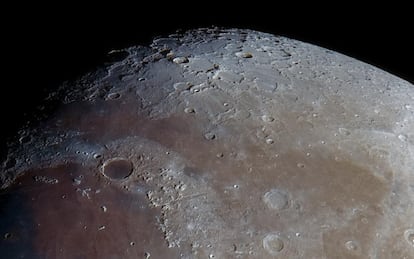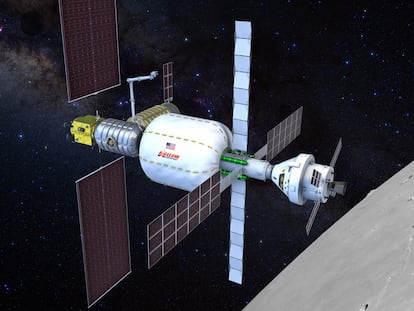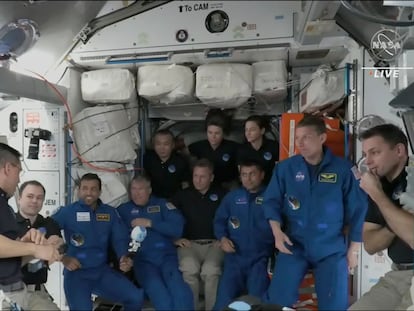Japan’s ispace seeks to land first private spacecraft on the Moon
The Japanese probe ‘Hakuto-R’ is attempting a historic landing in the Atlas crater, within the unexplored Mare Frigoris

“We believe that by 2040 the Moon will support a population of 1,000, with 10,000 people visiting every year.” That’s the hope of ispace, a Japanese lunar exploration company that will attempt on Tuesday to become the first privately-led mission to land on the Moon.
The Japanese probe Hakuto-R — which is about the size of a large refrigerator — will try to land in Atlas, an impact crater in the far north of the Moon, within the unexplored Mare Frigoris, or Sea of Cold. If it succeeds, it will not only become the first spacecraft to land in this area, but also the first private company to land on the lunar surface.
The goal of ispace is to lead the “space economy” by extracting water on the Moon and shipping experiments, supplies and other materials to government or corporate clients. “Imagine the Moon supporting construction, energy, steel procurement, communications, transportation, agriculture, medicine, and tourism,” the company states on its website.
As the great space powers prepare missions to return to the Moon, that forecast sounds increasingly realistic. The consulting firm PwC estimates that lunar transportation services will grow into a business worth $150 billion by 2036, compared to the current $6.6 billion. The Japanese company wants to be the first to start making a profit.
The ispace project has come out of a failure of sorts. Its goal was to win Google’s $20 million Lunar X Prize for the first company to land on the Moon and move 500 meters across its surface. The award was abandoned in 2018 after none of the candidates achieved that objective.
One of the contenders was Beresheet, a probe devised by three Israeli engineers that crashed in 2019. It was a disappointing end to an investment that cost almost €90 million ($99 million). The project was Israel’s attempt to become the fourth country to successfully land on the Moon after the United States, Russia and China. That’s the same goal now being pursued by ispace, which was founded by 44-year-old Japanese entrepreneur Takeshi Hakamada.
We’ve received another incredible photo from the camera onboard our Mission 1 lander!
— ispace (@ispace_inc) April 24, 2023
Seen here is the lunar Earthrise during solar eclipse, captured by the lander-mounted camera at an altitude of about 100 km from the lunar surface. (1/2) pic.twitter.com/pNSI4lPnux
In Japanese, Hakuto-R means “white rabbit” — a name is inspired by an Asian legend about a white rabbit on the Moon. Europe has made important contributions to the spacecraft. The European Space Agency is providing communication between the probe and the control center, which is located in Tokyo. The ship’s propulsion system and its final assembly were carried out by the European company Ariane.
The probe’s guidance system is made by Draper, a private aerospace laboratory based near Boston. Draper, which is collaborating with ispace, has already won one of NASA’s million-dollar contracts to bring scientific equipment to the Moon in 2025 as part of its Artemis program. The objective of Artemis — led by the United States, along with the Europe, Canada, Japan and other countries — is to return astronauts to the Moon in 2025 and develop a long-term presence there. Once settled, the goal is to extract water from the Moon and turn it into rocket fuel in a bid to reach Mars within two decades.
We are excited to share a new photo of the Moon taken by the lander's on-board camera from an altitude of about 100 km above the lunar surface. The photo was taken at 4:32 am on April 15 (JST). (1/2) pic.twitter.com/PWux4GJLIx
— ispace (@ispace_inc) April 24, 2023
Since its launch in December 2022, Hakuto-R has successfully met all its objectives. The idea was to reach the Moon in around five months, as this meant significant fuel savings. On April 14, the probe fired its engines for 10 minutes to adjust its orbit around the Moon and prepare for landing.
Hakuto-R has already sent back its first images of the lunar surface. Everything seems ready for landing. The probe is scheduled to fire its thrusters once again on Tuesday, when it will begin its descent from a height of 62 miles (100 kilometers). The spacecraft will start by nearing the Mare Frigoris, and approximately one hour later, it will attempt a soft landing in Atlas crater. The landing will be fully automatic. If there are any problems, the Japanese company will have more opportunities to attempt the landing this week and next.
Hakuto-R is carrying a small prototype of a lunar robot designed by the Japanese Space Agency. This robot will be used to carry out experiments with lunar regolith (the fine debris covering the Moon’s surface) and will take part in the development of Lunar Cruiser, a pressurized Moon rover developed with Toyota that could help astronauts live on the Moon. The Japanese probe is also carrying the United Arab Emirates’ Rashid rover.
Sign up for our weekly newsletter to get more English-language news coverage from EL PAÍS USA Edition
Tu suscripción se está usando en otro dispositivo
¿Quieres añadir otro usuario a tu suscripción?
Si continúas leyendo en este dispositivo, no se podrá leer en el otro.
FlechaTu suscripción se está usando en otro dispositivo y solo puedes acceder a EL PAÍS desde un dispositivo a la vez.
Si quieres compartir tu cuenta, cambia tu suscripción a la modalidad Premium, así podrás añadir otro usuario. Cada uno accederá con su propia cuenta de email, lo que os permitirá personalizar vuestra experiencia en EL PAÍS.
¿Tienes una suscripción de empresa? Accede aquí para contratar más cuentas.
En el caso de no saber quién está usando tu cuenta, te recomendamos cambiar tu contraseña aquí.
Si decides continuar compartiendo tu cuenta, este mensaje se mostrará en tu dispositivo y en el de la otra persona que está usando tu cuenta de forma indefinida, afectando a tu experiencia de lectura. Puedes consultar aquí los términos y condiciones de la suscripción digital.











































